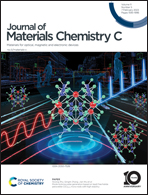A novel graphdiyne (CnH2n−2) synthesis strategy: design and application of an organic/inorganic conjugated system for photocatalytic hydrogen production
Abstract
Rational construction of effective carbon-based photocatalysts is a new idea and new direction to expand the research field of photocatalysis. Carbon elements have a variety of hybridization modes due to their unique electronic structure which can easily lead to the formation of conjugated structures. In this work, a novel preparation method of graphdiyne (GDY) was reported, and the conjugated structure photocatalyst was constructed with g-C3N4 based on the solvent-coordination molecular template (SCMT) mechanism. The electron-donating effect of the amino group effectively promoted the photogenerated carrier separation rate of g-C3N4, and the more negative conduction band potential provided a stronger thermodynamic driving force for the reduction reaction. Based on the conjugated structural advantage, the charge delocalization effect between g-C3N4 and GDY accelerates the surface migration rate of the photogenerated electrons. The synergistic interaction of ethylenediamine as a hole fixator and GDY as a hole inducer enhanced the H+ reduction reaction. The band structures of GDY and g-C3N4 were calculated based on first-principles density functional theory (DFT), and the hydroxyl radical capture and in situ XPS photocatalytic mechanisms were demonstrated. This work provides ideas for the design of photocatalyst systems and the application of carbon materials in photocatalysis.



 Please wait while we load your content...
Please wait while we load your content...